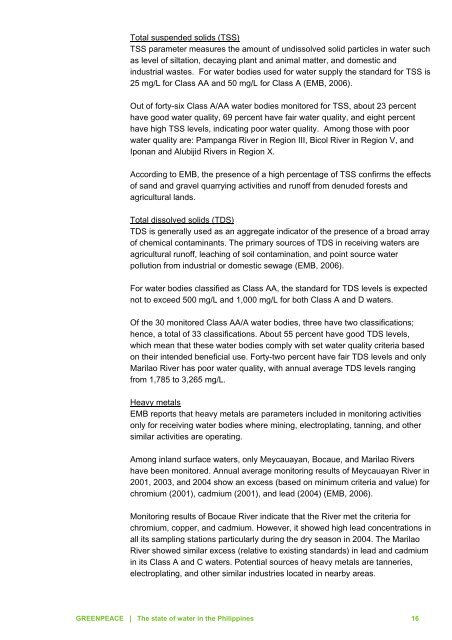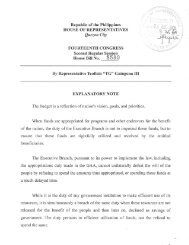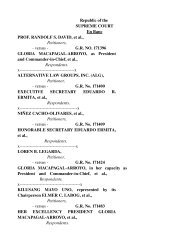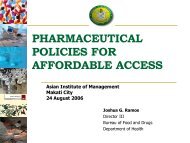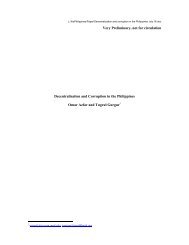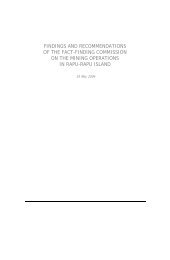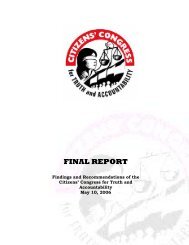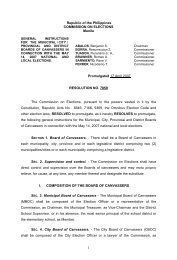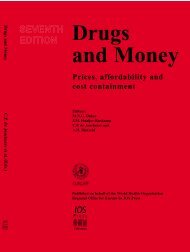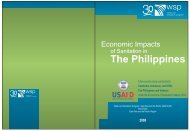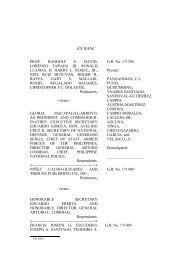The state of water resources in the Philippines - Greenpeace
The state of water resources in the Philippines - Greenpeace
The state of water resources in the Philippines - Greenpeace
Create successful ePaper yourself
Turn your PDF publications into a flip-book with our unique Google optimized e-Paper software.
Total suspended solids (TSS)<br />
TSS parameter measures <strong>the</strong> amount <strong>of</strong> undissolved solid particles <strong>in</strong> <strong>water</strong> such<br />
as level <strong>of</strong> siltation, decay<strong>in</strong>g plant and animal matter, and domestic and<br />
<strong>in</strong>dustrial wastes. For <strong>water</strong> bodies used for <strong>water</strong> supply <strong>the</strong> standard for TSS is<br />
25 mg/L for Class AA and 50 mg/L for Class A (EMB, 2006).<br />
Out <strong>of</strong> forty-six Class A/AA <strong>water</strong> bodies monitored for TSS, about 23 percent<br />
have good <strong>water</strong> quality, 69 percent have fair <strong>water</strong> quality, and eight percent<br />
have high TSS levels, <strong>in</strong>dicat<strong>in</strong>g poor <strong>water</strong> quality. Among those with poor<br />
<strong>water</strong> quality are: Pampanga River <strong>in</strong> Region III, Bicol River <strong>in</strong> Region V, and<br />
Iponan and Alubijid Rivers <strong>in</strong> Region X.<br />
Accord<strong>in</strong>g to EMB, <strong>the</strong> presence <strong>of</strong> a high percentage <strong>of</strong> TSS confirms <strong>the</strong> effects<br />
<strong>of</strong> sand and gravel quarry<strong>in</strong>g activities and run<strong>of</strong>f from denuded forests and<br />
agricultural lands.<br />
Total dissolved solids (TDS)<br />
TDS is generally used as an aggregate <strong>in</strong>dicator <strong>of</strong> <strong>the</strong> presence <strong>of</strong> a broad array<br />
<strong>of</strong> chemical contam<strong>in</strong>ants. <strong>The</strong> primary sources <strong>of</strong> TDS <strong>in</strong> receiv<strong>in</strong>g <strong>water</strong>s are<br />
agricultural run<strong>of</strong>f, leach<strong>in</strong>g <strong>of</strong> soil contam<strong>in</strong>ation, and po<strong>in</strong>t source <strong>water</strong><br />
pollution from <strong>in</strong>dustrial or domestic sewage (EMB, 2006).<br />
For <strong>water</strong> bodies classified as Class AA, <strong>the</strong> standard for TDS levels is expected<br />
not to exceed 500 mg/L and 1,000 mg/L for both Class A and D <strong>water</strong>s.<br />
Of <strong>the</strong> 30 monitored Class AA/A <strong>water</strong> bodies, three have two classifications;<br />
hence, a total <strong>of</strong> 33 classifications. About 55 percent have good TDS levels,<br />
which mean that <strong>the</strong>se <strong>water</strong> bodies comply with set <strong>water</strong> quality criteria based<br />
on <strong>the</strong>ir <strong>in</strong>tended beneficial use. Forty-two percent have fair TDS levels and only<br />
Marilao River has poor <strong>water</strong> quality, with annual average TDS levels rang<strong>in</strong>g<br />
from 1,785 to 3,265 mg/L.<br />
Heavy metals<br />
EMB reports that heavy metals are parameters <strong>in</strong>cluded <strong>in</strong> monitor<strong>in</strong>g activities<br />
only for receiv<strong>in</strong>g <strong>water</strong> bodies where m<strong>in</strong><strong>in</strong>g, electroplat<strong>in</strong>g, tann<strong>in</strong>g, and o<strong>the</strong>r<br />
similar activities are operat<strong>in</strong>g.<br />
Among <strong>in</strong>land surface <strong>water</strong>s, only Meycauayan, Bocaue, and Marilao Rivers<br />
have been monitored. Annual average monitor<strong>in</strong>g results <strong>of</strong> Meycauayan River <strong>in</strong><br />
2001, 2003, and 2004 show an excess (based on m<strong>in</strong>imum criteria and value) for<br />
chromium (2001), cadmium (2001), and lead (2004) (EMB, 2006).<br />
Monitor<strong>in</strong>g results <strong>of</strong> Bocaue River <strong>in</strong>dicate that <strong>the</strong> River met <strong>the</strong> criteria for<br />
chromium, copper, and cadmium. However, it showed high lead concentrations <strong>in</strong><br />
all its sampl<strong>in</strong>g stations particularly dur<strong>in</strong>g <strong>the</strong> dry season <strong>in</strong> 2004. <strong>The</strong> Marilao<br />
River showed similar excess (relative to exist<strong>in</strong>g standards) <strong>in</strong> lead and cadmium<br />
<strong>in</strong> its Class A and C <strong>water</strong>s. Potential sources <strong>of</strong> heavy metals are tanneries,<br />
electroplat<strong>in</strong>g, and o<strong>the</strong>r similar <strong>in</strong>dustries located <strong>in</strong> nearby areas.<br />
GREENPEACE | <strong>The</strong> <strong>state</strong> <strong>of</strong> <strong>water</strong> <strong>in</strong> <strong>the</strong> Philipp<strong>in</strong>es 16


